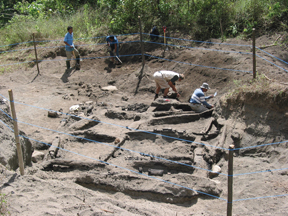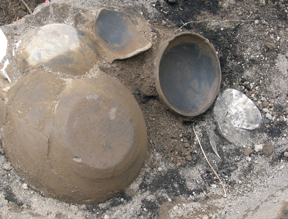Geotimes

Untitled Document

News Notes
Geoarchaeology
Seeing below Tambora
 On April 10,
1815, Mount Tambora, on the Indonesian island of Sumbawa, exploded in the largest
recorded eruption in human history. The eruption and its aftereffects extended
all over the world, causing the deaths of as many as 100,000 people. Few, if
any, of the estimated thousands of people living on the volcano’s slopes
survived, but new excavations there are shedding light on their lives.
On April 10,
1815, Mount Tambora, on the Indonesian island of Sumbawa, exploded in the largest
recorded eruption in human history. The eruption and its aftereffects extended
all over the world, causing the deaths of as many as 100,000 people. Few, if
any, of the estimated thousands of people living on the volcano’s slopes
survived, but new excavations there are shedding light on their lives.
Following ground-penetrating-radar surveys
that helped locate the site, researchers excavate a settlement buried by the
catastrophic 1815 volcanic eruption of Tambora in Indonesia. The team uncovered
melted glass, pottery and incinerated timbers and bodies at the site. Photos
are courtesy of URI News Bureau.
 Not one of
the 200 people who live in the village of Tambora today is a descendant of the
1815 inhabitants. When Haraldur Sigurdsson, volcanologist at the University
of Rhode Island in Narragansett, and his colleagues arrived at the village in
2004 to study the eruption site, they asked residents if they had seen potsherds
or any other artifacts. This inquiry led the researchers to a nearby gully.
Not one of
the 200 people who live in the village of Tambora today is a descendant of the
1815 inhabitants. When Haraldur Sigurdsson, volcanologist at the University
of Rhode Island in Narragansett, and his colleagues arrived at the village in
2004 to study the eruption site, they asked residents if they had seen potsherds
or any other artifacts. This inquiry led the researchers to a nearby gully.
Along the gully the team ran several ground penetrating radar (GPR) surveys
(see Geotimes, October 2005).
Because flooding had washed away the thickoverlay of ash flows covering the
gully, at only one-half meter below the surface “we could easily see buried
terraced soil horizons, which meant that people had been living there,”
says Lewis Abrams, an oceanographer at the University of North Carolina in Wilmington,
who was on the Tambora team. In other places, the ash and pumice layers were
several meters thick, but below, the researchers could see these same buried
soil surfaces.
They then “ground-truthed” the gully site by carefully digging. “It
matched what we thought,” Abrams says. “As we worked our way through
the gully, we found charred animal bones, melted glass jars, rice, potsherds,
bronze bowls, burnt timbers and the remains of two adult bodies,” he says.
The findings were part of a household that was fairly clearly delineated: One
of the charred bodies was in an area like a kitchen and was holding a large
metal knife, while the other body was on the doorstep.
The scene reminded Sigurdsson eerily of Pompeii, which was buried by the A.D.
79 eruption of Vesuvius — except that this was a much hotter, more destructive
eruption. The surge of material streaming down the volcano was probably 1,000
degrees Celsius, Abrams says, and would have incinerated everything in its way.
In 1815, Tambora may have had up to 10,000 residents and been a small wealthy
kingdom, known for its honey, horses, sappanwood (used to make red dye) and
sandalwood, according to some historical descriptions from Dutch and British
explorers. Sigurdsson suggests that if that is the case, there could be much
more to uncover, including wealthy abodes and a palace, he noted in a press
release.
John Miksic, an archaeologist and specialist in Southeast Asia at the National
University of Singapore, urges caution before drawing conclusions regarding
the significance of the area. “I have heard that much of the area has been
looted by treasure seekers, so I am not sure how much is actually left,”
Miksic says. Furthermore, he says, rather than being a major economic or political
center with distinctive characteristics, Tambora likely formed part of a greater
society encompassing several islands, including Bali and Sulawesi.
Sigurdsson’s and his colleagues’ excavations “so far seem quite
limited,” Miksic says, “not enough to draw any conclusions regarding
the economy or social structure of the entire region affected by the eruption.”
However, he says, the excavations “are the first aimed at studying the
remains of the society in the Tambora area on the eve of the eruption, so more
research aimed at following up Sigurdsson’s initial exploration would definitely
be beneficial.”
Later this year or early next year, Sigurdsson’s team plans to return
to the site for further GPR surveying and excavations, Abrams says.
Megan Sever
Links:
"Geophysics and archaeology collide,"
Geotimes, October 2005
University
of Rhode Island news site on Tambora finds
Back to top
Untitled Document

 On April 10,
1815, Mount Tambora, on the Indonesian island of Sumbawa, exploded in the largest
recorded eruption in human history. The eruption and its aftereffects extended
all over the world, causing the deaths of as many as 100,000 people. Few, if
any, of the estimated thousands of people living on the volcano’s slopes
survived, but new excavations there are shedding light on their lives.
On April 10,
1815, Mount Tambora, on the Indonesian island of Sumbawa, exploded in the largest
recorded eruption in human history. The eruption and its aftereffects extended
all over the world, causing the deaths of as many as 100,000 people. Few, if
any, of the estimated thousands of people living on the volcano’s slopes
survived, but new excavations there are shedding light on their lives. 
 Not one of
the 200 people who live in the village of Tambora today is a descendant of the
1815 inhabitants. When Haraldur Sigurdsson, volcanologist at the University
of Rhode Island in Narragansett, and his colleagues arrived at the village in
2004 to study the eruption site, they asked residents if they had seen potsherds
or any other artifacts. This inquiry led the researchers to a nearby gully.
Not one of
the 200 people who live in the village of Tambora today is a descendant of the
1815 inhabitants. When Haraldur Sigurdsson, volcanologist at the University
of Rhode Island in Narragansett, and his colleagues arrived at the village in
2004 to study the eruption site, they asked residents if they had seen potsherds
or any other artifacts. This inquiry led the researchers to a nearby gully.
